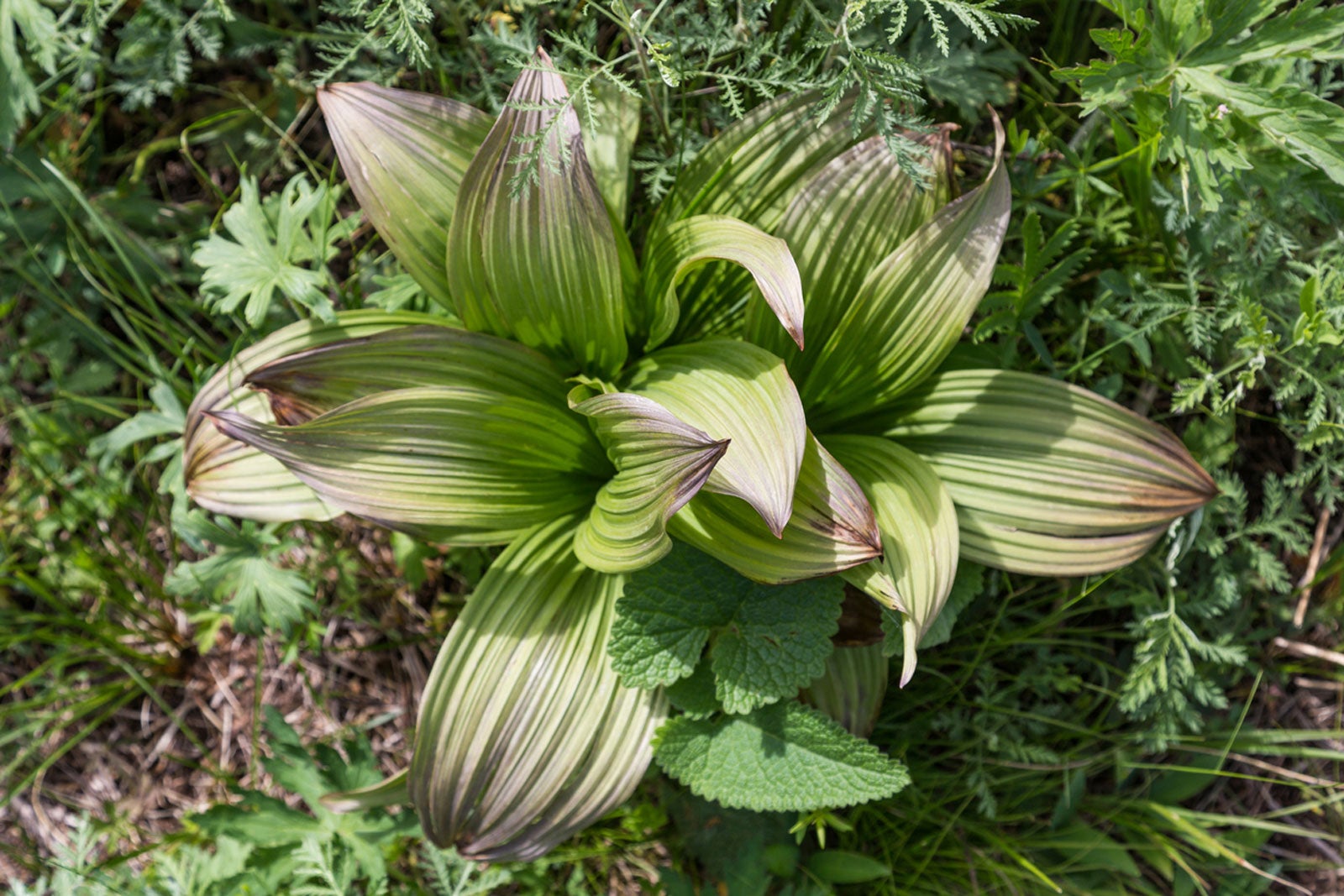What Is False Hellebore – Learn About Indian Poke Plants


False hellebore plants (Veratrum californicam) are native to North America and have a deeply rooted culture in First Nation’s history. What is false hellebore? The plants have many common names, including:
- Indian poke plants
- Corn lily
- American false hellebore
- Duck retten
- Earth gall
- Devil’s bite
- Bear corn
- Tickle weed
- Devil's tobacco
- American hellebore
- Green hellebore
- Itch weed
- Swamp hellebore
- White hellebore
They are not related to hellebore plants, which are in the Ranunculus family, but are instead in the family Melanthiaceae. False hellebore flowers may be in bloom in your backyard.
What is False Hellebore?
Indian poke plants come in two varieties: Veratrum viride var. viride is native to eastern North America. The inflorescence may be erect or spreading. Veratrum viride var. eschscholzianum is a western North America denizen with drooping side branches of inflorescence. The eastern native is generally found in Canada, while the western variety may span a range from Alaska to British Columbia, down into the western states to California. They are wildly growing herbaceous perennials. You can recognize this plant by its size, which may achieve 6 feet (2 m.) or more in stature. The leaves are also striking, having large oval, pleated basal leaves up to 12 inches (31 cm.) long and smaller, sparser stem leaves. The huge leaves may span 3 to 6 inches (8-15 cm.) in diameter. The foliage makes up the bulk of the plant but it does produce spectacular inflorescences in summer until the fall. False hellebore flowers are on erect 24 inch long (61 cm.) stems with clusters of 3/4 inch (2 cm.) yellow, star-shaped florets. The roots of this plant are poisonous and leaves and flowers are toxic and may cause illness.
Growing False Hellebore Indian Poke
False hellebore plants reproduce primarily through seed. Seeds are borne in tiny three-chambered capsules which crack open to release seed when ripe. Seeds are flat, brown, and winged to better catch on wind gusts and spread across the area. You may harvest these seeds and plant them in prepared beds in a sunny location. These plants prefer boggy soil and are often found near swamps and low ground. Once germination takes place, they need little care except for consistent moisture. Remove the seed heads in late summer if you don’t wish to have the plant in all areas of the garden. The leaves and stems will die back with the first freeze and re-sprout in early spring.
History of False Hellebore Use
Traditionally, the plant was used in small quantities orally as a medicine for pain. Roots were used dried to topically treat bruises, sprains, and fractures. Oddly, once the plant experiences a freeze and dies back, the toxins decrease and animals can eat remaining parts without trouble. Roots were harvested in fall after a freeze when they are less dangerous. A decoction was part of a treatment for chronic cough and constipation. Chewing small parts of the root helped stomach pain. There are no current modern uses for the plant, although it contains alkaloids that may have the potential to treat high blood pressure and rapid heart rate. Fibers from the stems were used to make fabric. The ground dried root has effective pesticide properties. First Nations people were also growing green false hellebore to grind the root and use as laundry soap. Today, however, it is just another of the wild wonders in this great land of ours and should be enjoyed for its beauty and magnificent stature. Note: It should be noted that this plant is considered toxic to many types of livestock, especially sheep. If you're raising livestock or live near a pasture, use caution if choosing to include this in the garden.
Gardening tips, videos, info and more delivered right to your inbox!
Sign up for the Gardening Know How newsletter today and receive a free copy of our e-book "How to Grow Delicious Tomatoes".

Bonnie Grant is a professional landscaper with a Certification in Urban Gardening. She has been gardening and writing for 15 years. A former professional chef, she has a passion for edible landscaping.
-
 Looking For Plants To Give You The Soft And Fuzzies? Try These 5 Fuzzy Leaf Plant Options
Looking For Plants To Give You The Soft And Fuzzies? Try These 5 Fuzzy Leaf Plant OptionsLovers of texture, drama, silver foliage and tactile plants will adore these special sensory garden additions. These fuzzy leaf plant options will leave you all aglow
By Susan Albert
-
 Get Ready For A Summer Of Hummers! Grow These Full Sun Hummingbird Plants and Flowers
Get Ready For A Summer Of Hummers! Grow These Full Sun Hummingbird Plants and FlowersIf you’re lucky enough to enjoy a sunny backyard, make sure you are maxing out on your pollinator opportunities and grow these full sun hummingbird plants and flowers
By Tonya Barnett